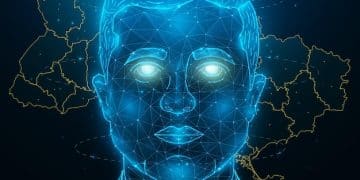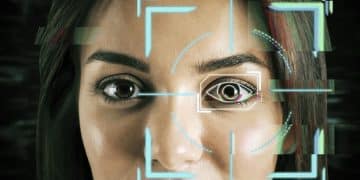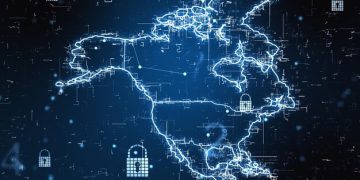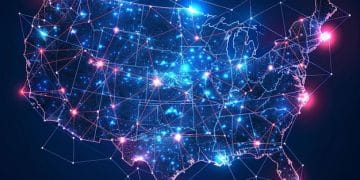Facial Recognition Ethics: US Stance in 2025

The evolving ethical landscape surrounding facial recognition technology in the US by 2025 sees a complex interplay of privacy concerns, legislative efforts, and technological advancements seeking to balance security needs with civil liberties.
The ubiquity of digital technology has interwoven itself into the fabric of our daily lives, and among its most powerful yet contentious innovations is facial recognition. As we navigate 2025, the critical question arises: The Ethics of Facial Recognition Technology: Where Does the US Stand in 2025? This powerful tool, capable of identifying individuals in real-time, presents a fascinating duality—a promise of enhanced security and convenience alongside profound concerns about privacy, surveillance, and potential misuse.
The Evolving Landscape of Facial Recognition in the US
Facial recognition technology in the United States, by 2025, has become a pervasive, yet often invisible, part of both public and private sectors. Its applications range from unlocking personal smartphones to enhancing security at airports and identifying suspects in criminal investigations. This widespread adoption, however, has ignited vigorous debates concerning its ethical implications and the boundaries of its implementation.
Rapid Technological Advancements
The pace of innovation in facial recognition algorithms continues to accelerate, with systems becoming more accurate, faster, and capable of operating in diverse conditions. Artificial intelligence and machine learning have pushed these capabilities beyond initial expectations, allowing for recognition even in challenging scenarios such as low light or obscured faces. This improved precision brings both greater utility and magnified ethical dilemmas.
- Enhanced Accuracy: Modern systems boast impressive accuracy rates, even with partial facial views or aging.
- Real-time Processing: Live feeds can be analyzed instantaneously, enabling rapid identification.
- Integration Capabilities: Seamless integration into existing CCTV networks and smart devices expands reach.
Diverse Applications Across Sectors
From retail analytics tracking customer movements to law enforcement utilizing databases for suspect identification, the technology’s footprint is extensive. Commercial entities employ it for personalized advertising and theft prevention, while government agencies explore its potential for border control and public safety monitoring. This variety of uses necessitates a nuanced approach to regulation, as each application carries distinct ethical considerations. The conversation around facial recognition by 2025 is no longer about hypothetical scenarios but about real-world deployments and their societal impacts. Lawmakers, tech companies, and civil liberties advocates are grappling with how best to harness its benefits while mitigating its significant risks, particularly in a nation that values individual freedoms deeply.
The current ethical considerations surrounding facial recognition technology are multifaceted, touching upon privacy, civil liberties, and the foundational principles of a democratic society. As the technology becomes more sophisticated and widespread, the challenge lies in establishing robust frameworks that protect individuals while allowing for legitimate and beneficial applications. This delicate balance is at the forefront of policy discussions across the US.
Privacy Concerns: A Digital Eye on Public Life
The core of the ethical debate surrounding facial recognition technology revolves around privacy. The ability to identify individuals without their consent in public spaces blurs the lines between public and private life, raising questions about what it means to be truly anonymous in an increasingly surveilled society. By 2025, the proliferation of cameras and advanced recognition systems means that individuals can be tracked, cataloged, and analyzed at unprecedented levels.
Erosion of Anonymity and Tracking
One of the most significant and immediate impacts is the erosion of anonymity in public spaces. Previously, moving through a crowd offered a degree of personal privacy; facial recognition negates this. Individuals can be identified entering specific locations, attending protests, or simply going about their daily routines, creating a comprehensive digital footprint without their knowledge or consent. This data can then be cross-referenced with other digital information, painting a detailed picture of a person’s life.

The potential for constant surveillance raises serious concerns for civil liberties. The fear of being watched can lead to self-censorship, suppressing free speech and association, which are cornerstones of democratic societies. When individuals feel their movements and expressions are being monitored, they may become less willing to participate in public discourse or engage in activities that could be misinterpreted or used against them. This chilling effect can undermine fundamental rights and civic engagement.
Data Security and Misuse Risks
Beyond the immediate privacy invasion, there are significant risks associated with the storage and security of facial data. Large databases of biometric information are attractive targets for cybercriminals and can be vulnerable to breaches. The misuse of this data—whether through unauthorized access, sharing with third parties, or repurposing for commercial or political exploitation—presents a serious threat. Once biometric data is compromised, it cannot be changed like a password, making the ramifications potentially permanent.
Furthermore, the potential for discriminatory use of facial recognition technology is a pressing concern. Biases in algorithms can lead to disproportionate misidentification of certain demographic groups, particularly women and people of color, which can have severe consequences, especially in law enforcement applications. Addressing these inherent biases, ensuring data security, and developing an oversight framework are critical steps in mitigating the profound privacy risks posed by this powerful technology by 2025. Without robust safeguards, the digital eye poses a significant threat to individual autonomy and societal trust.
Accuracy, Bias, and Discrimination
The efficacy and fairness of facial recognition technology are intricately linked to its accuracy and the presence of algorithmic biases. While advancements have significantly improved overall performance, persistent issues regarding misidentification and discriminatory outcomes remain a critical ethical concern. By 2025, understanding and mitigating these flaws are paramount to responsible deployment.
Algorithmic Biases and Disparate Impact
Research has consistently shown that facial recognition systems can exhibit performance disparities across different demographic groups. Studies by the National Institute of Standards and Technology (NIST), among others, have highlighted higher rates of misidentification for women, individuals with darker skin tones, and elderly populations. These biases are often inherited from the training data, which may not adequately represent the diversity of the population, leading to less accurate recognition for underrepresented groups.
- Training Data Imbalances: Datasets lacking diversity can perpetuate and amplify existing societal biases.
- Feature Recognition Challenges: Algorithms may struggle with varied skin tones, lighting conditions, and facial structures.
- Compounding Effects: Lower accuracy for certain groups can lead to disproportionate rates of wrongful arrests or denials of service.
Consequences for Vulnerable Populations
The real-world implications of biased facial recognition are severe, particularly for vulnerable communities. In law enforcement contexts, a higher rate of false positives for minority groups can lead to wrongful arrests, increased police scrutiny, and a further erosion of trust in legal institutions. For instance, an individual who is misidentified could face significant legal turmoil, reputational damage, and emotional distress, even if eventually cleared.

In commercial applications, biased systems could lead to unfair access to services, employment opportunities, or even targeted surveillance based on demographic characteristics. Imagine a scenario where a system, due to inherent bias, flags certain individuals as “high-risk” based on their appearance, leading to discriminatory treatment in retail, housing, or financial services. These outcomes perpetuate and exacerbate existing social inequalities.
Addressing these issues requires a multi-pronged approach. It includes developing more diverse and representative training datasets, implementing rigorous testing and auditing mechanisms to identify and correct biases, and establishing clear accountability frameworks for developers and deployers of facial recognition technology. Without a concerted effort to ensure fairness and accuracy across all demographics, the ethical deployment of facial recognition technology remains deeply problematic in the US by 2025. The pursuit of technological advancement must not come at the cost of equity and justice for all citizens.
Legislative Efforts and Policy Debates in the US
The absence of a comprehensive federal framework for facial recognition technology creates a patchwork of regulations across the United States. While some states and municipalities have taken proactive steps to restrict or ban its use, others have adopted a more permissive stance, leading to a complex and often contradictory legal landscape in 2025. This fragmented approach underscores the urgent need for a cohesive national strategy.
State and Local Restrictions vs. Federal Inaction
A growing number of cities and states have implemented varying degrees of bans or restrictions on facial recognition technology, particularly for use by law enforcement and government agencies. San Francisco was among the first major cities to ban its use by city departments in 2019, soon followed by others like Boston and Portland. These local initiatives often cite concerns over civil liberties, privacy, and the potential for misuse. However, the federal government has largely refrained from enacting broad legislation, leaving a vacuum that complexifies the legal and ethical environment. This lack of federal oversight means departments operating across state lines face inconsistent regulatory environments, hindering uniform practices.
Proposed Federal Legislation and Guidelines
Several pieces of federal legislation have been proposed in Congress, aiming to establish national standards for facial recognition technology. These proposals typically seek to address issues such as:
- Consent Requirements: Mandating consent for the collection and use of facial data in certain contexts.
- Transparency Obligations: Requiring agencies and companies to disclose their use of facial recognition.
- Independent Audits: Establishing processes for third-party evaluation of algorithmic bias and accuracy.
- Moratoriums: Proposing temporary or permanent bans on specific uses of the technology, especially in sensitive areas.
However, these legislative efforts have faced significant challenges, including political gridlock, disagreements over the scope of regulation, and strong lobbying from tech companies and law enforcement agencies. The balance between national security interests and individual privacy rights remains a contentious point, making it difficult to forge bipartisan consensus. The debates often center on whether the technology should be banned outright, subject to strict regulations, or allowed with minimal oversight.
By 2025, the US stands at a critical juncture regarding facial recognition policy. The continued legislative inaction at the federal level risks creating a digital Wild West, where the deployment of powerful surveillance tools outpaces the necessary legal and ethical safeguards. A uniform, thoughtful, and rights-respecting federal framework is essential to ensure responsible innovation and protect the fundamental freedoms of American citizens in the face of increasingly sophisticated technology.
Balancing Security and Civil Liberties
The fundamental challenge in the discourse around facial recognition technology is the inherent tension between enhancing public safety and preserving civil liberties. On one hand, proponents argue for its undeniable utility in security, while critics warn of its potential for widespread surveillance and abuse. Striking an equitable balance is not merely a legal exercise but a societal imperative as we assess the US position in 2025.
Arguments for Security and Efficacy
Advocates for facial recognition technology emphasize its potential to augment security measures significantly. For law enforcement, it offers a powerful tool for identifying criminal suspects, locating missing persons, and preventing acts of terrorism. In public spaces, it could enhance safety by deterring crime and assisting in emergency response. Companies utilize it for access control, preventing fraud, and personalizing consumer experiences. The narrative often centers on efficiency and effectiveness—the ability to identify individuals faster and more accurately than traditional methods, thereby contributing to a safer environment. The technology is presented as a necessary evolution of surveillance in an increasingly complex world.
Concerns for Overreach and Surveillance
Conversely, civil liberties advocates express profound concerns that the widespread deployment of facial recognition, particularly by government agencies, could lead to an unprecedented level of pervasive surveillance. The ability to track individuals’ movements, associations, and behaviors without their consent or knowledge raises fears of a “surveillance state,” where privacy is an illusion. There’s a tangible risk of mission creep, where technology initially deployed for specific security purposes expands to general population monitoring.
Beyond the erosion of privacy, the potential for misuse and abuse looms large. This includes:
- Targeting Dissidents: Using the technology to identify and suppress political protestors or minority groups.
- Chilling Effect on Speech: Individuals self-censoring their expressions or activities due to fear of being monitored.
- Errors and False Positives: The consequence of misidentification, especially for marginalized communities, leading to wrongful arrests.
- Lack of Transparency: The clandestine nature of many facial recognition deployments means the public is largely unaware of when and where they are being subjected to this technology.
The ethical dilemma of facial recognition in the US by 2025 is not about choosing between security and freedom, but rather about ensuring that security enhancements do not inadvertently erode the very civil liberties they aim to protect. This requires careful consideration of proportionality, robust oversight mechanisms, accountability for misuse, and a commitment to transparency. Only through open dialogue and democratic decision-making can a durable balance be achieved, safeguarding both public safety and fundamental human rights.
The Role of Public Opinion and Advocacy Groups
Public discourse and the persistent efforts of advocacy groups play a pivotal role in shaping the ethical trajectory and regulatory landscape of facial recognition technology in the US by 2025. Their voices often highlight issues that might otherwise be overlooked by policymakers, pushing for greater accountability and transparency.
Growing Public Skepticism and Concern
As facial recognition technology becomes more visible and its implications more widely understood, public skepticism and concern have grown. Surveys consistently show that a significant portion of the American public harbors deep reservations about its use, particularly by law enforcement and government agencies, citing fears of privacy invasion and potential for abuse. Personal experiences with data breaches, coupled with a general distrust in large institutions, fuel this apprehension. This public sentiment often translates into support for stricter regulations or outright bans, signaling a critical demand for greater control and oversight over this powerful technology. Media coverage, highlighting both the benefits and pitfalls, also contributes significantly to this evolving public perception.
Influence of Civil Liberties and Tech Activist Groups
Civil liberties organizations, such as the American Civil Liberties Union (ACLU), and tech activist groups have been at the forefront of advocating for robust safeguards and moratoriums on facial recognition. They engage in various activities to influence policy and public opinion:
- Litigation: Challenging the legality of facial recognition deployments in courts.
- Lobbying: Advocating directly to lawmakers at federal, state, and local levels for protective legislation.
- Public Awareness Campaigns: Educating the public about the risks and ethical implications of the technology.
- Research and Reporting: Publishing reports on algorithmic bias, surveillance harms, and privacy violations.
These groups serve as crucial watchdogs, holding both government agencies and private companies accountable. Their efforts have been instrumental in pushing for moratoriums in cities, influencing proposed federal legislation, and raising crucial questions about the democratic implications of pervasive surveillance. They often partner with academic researchers to provide evidence-based arguments against unregulated use, emphasizing the long-term societal impacts.
The dialogue surrounding facial recognition in 2025 is heavily influenced by this ongoing interplay between public concern and the strategic advocacy of these groups. Their collective pressure ensures that ethical considerations remain at the forefront of policy debates, compelling lawmakers to grapple with the complex balance between technological advancement, national security, and fundamental human rights. Without their sustained efforts, the trajectory of facial recognition deployment in the US would likely be far less constrained and accountable.
The Future: Towards a Responsible Framework?
As the US stands in 2025, the journey towards a comprehensive and responsible framework for facial recognition technology is ongoing and fraught with complexities. The trajectory suggests an increasing recognition of the need for structured governance, moving beyond the current decentralized approach. The path forward includes a combination of legislative action, technological accountability, and robust public engagement to ensure ethical deployment.
### Calls for Comprehensive Federal Regulation
The fragmented nature of current regulations has highlighted the critical need for a uniform federal approach. While local bans provide some protection, they create a chaotic legal environment that fails to address the technology’s broader implications. There is a growing consensus among civil liberties advocates, some industry leaders, and a segment of policymakers that national standards are imperative. Such legislation would likely aim to:
- Establish Clear Use Cases: Define permissible and prohibited applications for facial recognition across public and private sectors.
- Implement Strong Privacy Protections: Mandate consent, data minimization, and secure storage for biometric information.
- Address Algorithmic Bias: Require regular, independent audits to detect and mitigate discriminatory outcomes.
- Ensure Transparency and Oversight: Demand public disclosure of deployments and establish independent review bodies.
The challenge remains in overcoming political divides and vested interests to craft legislation that is both effective and fair. The debate over a potential federal moratorium versus strict regulation continues to simmer, indicating that consensus will require significant effort and compromise.
Technological Innovations and Ethical Design
Beyond legislation, the tech industry itself has a crucial role to play in fostering ethical development. This involves a commitment to ‘privacy by design’ and ‘ethics by design,’ embedding protective measures and fair principles into the technology from its inception. Researchers are actively working on ways to reduce bias in algorithms, improve transparency in system operations, and develop privacy-enhancing technologies that can work in conjunction with facial recognition. For example, advancements in differential privacy and federated learning could allow for valuable insights from facial data without compromising individual identities. Companies are also exploring self-regulatory measures and industry best practices to preempt government intervention, although these often face skepticism from civil liberties groups concerned about potential conflicts of interest. The emphasis is shifting towards not just what the technology can do, but what it *should* do, and how it can be built responsibly.
The International Context and Global Best Practices
The US ethical framework for facial recognition will also likely be influenced by international developments. Countries and blocs like the European Union have taken more assertive stances, with proposals for stricter regulations, and even bans on certain uses of AI, including facial recognition. Learning from these global best practices as well as avoiding pitfalls could inform US policy. As technologies transcend national borders, there is an increasing recognition of the need for international cooperation to address the universal challenges posed by facial recognition. The future of facial recognition in the US in 2025 hinges on a confluence of proactive legislative measures, ethical technological innovation, and a sustained commitment to robust public dialogue. The goal must be to create a framework that harnesses the technology’s potential benefits while unequivocally safeguarding fundamental rights in an increasingly digital world.
| Key Point | Brief Description |
|---|---|
| 👁️ Privacy Concerns | Erosion of anonymity and potential for pervasive surveillance in public and private spaces. |
| ⚖️ Legislative Chaos | Fragmented state/local regulations, but lacking comprehensive federal framework in the US. |
| ✊ Advocacy Impact | Public opinion and civil liberties groups drive the debate for ethical use and accountability. |
| 🔄 Ethical Solutions | Calls for federal laws, ethical AI design, and international cooperation to balance security and rights. |
Frequently Asked Questions About Facial Recognition Ethics in the US
The primary ethical concerns include pervasive surveillance, erosion of privacy and anonymity in public spaces, potential for algorithmic bias leading to discriminatory outcomes, risks of data misuse, and the chilling effect on civil liberties like freedom of speech and assembly. These issues pose significant challenges to individual rights.
Algorithmic bias occurs when facial recognition systems perform less accurately for certain demographic groups due to imbalanced training data. Women, individuals with darker skin tones, and elderly populations often experience higher rates of misidentification. This can lead to disproportionate and unjust outcomes, particularly in law enforcement contexts, such as wrongful arrests.
By 2025, the US lacks a comprehensive federal law regulating facial recognition. This has resulted in a patchwork of regulations, with some states and municipalities implementing bans or restrictions, especially for government use, while others have few limitations. This creates legal inconsistencies and a complex regulatory landscape.
Civil liberties groups like the ACLU are instrumental in advocating for stricter regulations and moratoriums on facial recognition. They engage in public awareness campaigns, lobby lawmakers, challenge deployments through litigation, and publish research highlighting the technology’s risks, ensuring that ethical considerations remain central to policy discussions.
Proposed steps include developing comprehensive federal legislation with clear use cases, strong privacy protections, and mandated bias audits. There’s also a push for ethical design principles within the tech industry, emphasizing transparency and accountability. International best practices are also being considered to inform robust and responsible governance frameworks.
Conclusion
The ethical landscape surrounding facial recognition technology in the United States by 2025 is defined by a dynamic interplay of rapid innovation, profound privacy concerns, fragmented legal responses, and persistent advocacy. The core challenge lies in navigating the tension between leveraging this powerful tool for security and convenience, while rigorously safeguarding fundamental civil liberties and preventing discrimination. As the technology continues to evolve, the demand for a coherent, rights-respecting federal framework grows louder, aiming to ensure that the benefits of facial recognition do not come at the irreparable cost of individual autonomy and societal trust. The future hinges on informed public discourse and a collective commitment to responsible and equitable technological governance.





